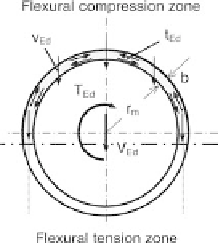Environmental Engineering Reference
In-Depth Information
Fig. 4.19 Action effects on opening joint between precast concrete elements
v
Rd
;
ct
¼m s
Nd
b
þ
v
Rdj
;
sy
v
Rdj
;
max
with the following flexural compressive stress varying over the flexural compression zone:
s
Nd
¼ s
cd
ð
R
m
cos
wÞ
f
cd
The resultant shear force that can be accommodated via the area of the flexural
compression zone is therefore
V
Rd
;
ct
¼m
F
cd
The loadbearing reserves of the prestressing steel (as a contribution to v
Rdj,sy
) cannot be
activated in this simplified structural model.
A Bredt shear flow can no longer be established in the overcompressed partial cross-
section and so the torque must be accommodated solely via the St. Venant moment of
resistance:
t
Rd c
ðÞ
¼m s
Nd
b
2
=
3
or
T
Rd c
ðÞ
¼m
F
cd
b
=
3
In a similar way to DIN 1045-1 [33] 10.4.2 (5), a quadratic interaction can be assumed
for the combined analysis of the load-carrying capacity:
2
2
V
Ed
V
Rd
;
ct
T
Ed
T
Rd c
ðÞ
þ
1
As the St. Venant torsional capacity is low, it can be critical for determining the
thickness of the shell required for the tower.
An alternative would be to provide keyed joints (joggle joints) between the precast
concrete elements, in a similar way to prestressed precast concrete bridges.



